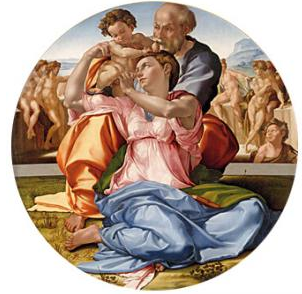Michelangelo at the Uffizi Gallery: the Doni Tondo
Due to the acclaim that met the Pietà in Rome, Michelangelo upon returning to Florence was bombarded with commissions, among them, as has been seen, the crucially important one for the David . The other works from this most intense Florentine period are: another bronze David (now lost) for the French Marshal Pierre de Rohan; the twelve Apostles commissioned by the Wool Guild for the Florentine Cathedral, of which only a Saint Matthew was to be roughed out; the Madonna and the Child bought by the Mouscron family from Bruges for their chapel in the Notre-Dame Church in the Flemish city; the Pitti Tondo and the Taddei Tondo, so called from the names of their clients, as well as the very famous work that introduced Michelangelo as a painter, the Doni Tondo (now at the Uffizi Gallery in Florence); and lastly, the unfinished Battle of Cascina.
 The Doni Tondo is considered to be the only panel painting by Michelangelo although some experts are also inclined to attribute to the artist a few paintings accomplished before the masterpiece now in the Uffizi, such as the so-called Manchester Madonna, now at the National Gallery in London and, with more caution, the Deposition in the Tomb from the same museum.
The Doni Tondo is considered to be the only panel painting by Michelangelo although some experts are also inclined to attribute to the artist a few paintings accomplished before the masterpiece now in the Uffizi, such as the so-called Manchester Madonna, now at the National Gallery in London and, with more caution, the Deposition in the Tomb from the same museum.
The Holy Family of the Doni Tondo was painted for Agnolo Doni and his wife Maddalena Strozzi, perhaps on the occasion of their marriage, celebrated between 1503 and 1504 or, it has been suggested, some years later, between 1506 and 1507; in any case, some time around that 1506, when another great artist of the period, Raphael, painted splendid portraits of the married couple. The composition on a round support follow the most typical 15th century Florentine tradition, having been used, for example, in the Madonna of the Pomegranate by Sandro Botticelli and the Madonna of Humility by Luca Signorelli, from which Michelangelo obviously drew some inspiration.
In the Doni Tondo, however, Michelangelo’s bold experimentation is already accentuated. In the first place, the iconography of the group with the Madonna twisting to receive, over her shoulder, the Child handed her by Saint Joseph, is unsual. The virgin appearence too is atipycal. Maria has strong, robust features and is portrayed without a veil, dressed in classical style with bare arms, a physiognomy that seems to anticipate the Sibyls painted on the ceiling of the Sistine Chapel. Then there are the colours: light and cold, harshly juxtaposed and iridiscent, a color scheme that is a prelude to the palette revealed by restoration of the Sistine, in sharp contrast with the taste of the period for pleasing, harmoniuos tones. Moreover, the young nudes in the background recall the “Ignudi” painted on the famous celeing of the Sistine.
Already in the Doni Tondo, as later in the masterpiece frescoed in the Vatican, Michelangelo’s work appears to painted sculpture, with the holy group in the Uffizi panel showing a strong three-dimensional effect, its plasticity underlined still further by the sharp contrast between light and shadow. As regards its meaning, the Florentine painting seems to allude to the division of humanity before and after the birth of Christ. If so, the nudes in the background are not classical figures of shepherds, as in the painting by Luca Signorelli, but probably represent the pagan world before Revelation.









